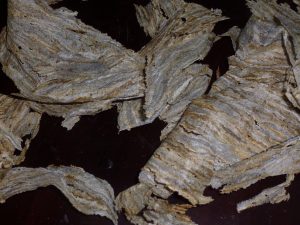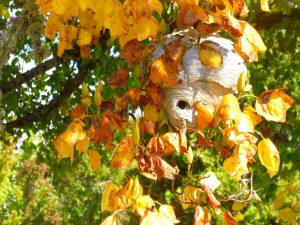The hornets and yellowjackets are cruising for their last snacks before the frost gets them. Yellowjackets have been particularly annoying, lately, buzzing around hair and exposed skin. If you stay calm while brushing them away, they seldom sting. They appear to be curious, more than aggressive, perhaps they want to taste the perspiration on skin, or whatever moisturizer one happens to be using.
In September at the Coho retreat at Camp Whispering Winds, I found some paper from a hornets nest lying in the woods. It consists of a beautiful blend of different kinds of wood pulp, blended with the saliva of the bald-faced hornet. Their nests are frequently way up in the trees, on a completely different level than human habitation, so I seldom notice them. It was a gift to find this fragile paper lying on the ground.
 Later, I came upon this hornet nest in the cemetery, next door to Coho. It was close to the ground. I watched it for two weeks and never saw a hornet. Assuming that the county had the nest emptied by our local hornet collector, Austin helped me get the nest. (Yes, there is a guy who collects hornets and yellowjackets from their nests and sends them off to a lab that creates an anti-venom to treat people who have been severely stung, or who may be allergic to stings.) We got it before it was damaged by a lot of rain. So, if you would like to see it, check out our porch. We figure it will be a scary Halloween decoration, if anyone happens to look up. It is probably full of larvae who starved to death after the adults were removed, so it might not smell all that good until it is sufficiently dried out. We also have a hornet who fell out of the nest, so you can see what the inhabitants looked like.
Later, I came upon this hornet nest in the cemetery, next door to Coho. It was close to the ground. I watched it for two weeks and never saw a hornet. Assuming that the county had the nest emptied by our local hornet collector, Austin helped me get the nest. (Yes, there is a guy who collects hornets and yellowjackets from their nests and sends them off to a lab that creates an anti-venom to treat people who have been severely stung, or who may be allergic to stings.) We got it before it was damaged by a lot of rain. So, if you would like to see it, check out our porch. We figure it will be a scary Halloween decoration, if anyone happens to look up. It is probably full of larvae who starved to death after the adults were removed, so it might not smell all that good until it is sufficiently dried out. We also have a hornet who fell out of the nest, so you can see what the inhabitants looked like.
To learn more about hornets, please check out this German website, written by someone who clearly loves hornets. You can see the life cycle of the hornets, photos of the larvae in their kindergarten (cute!), and learn lots of interesting facts about hornets, such as this interesting tidbit: “Hornets are the top predators of the insect world comparable with the birds of prey in the bird world. They are the eagles of the insects. Gardeners should be glad to have a hornet nest nearby!” Somewhere later in the article, I found a statement that the bald-faced hornet, native to North America is not a real hornet. Well, if you would like a close-up look at our “not-real” hornet, drop by.